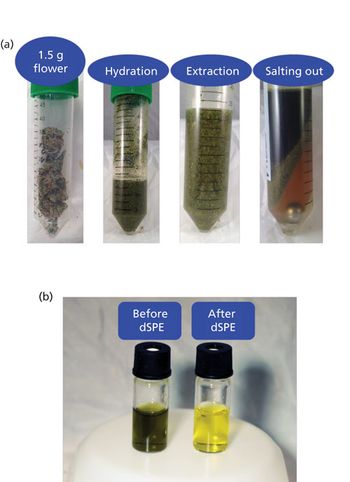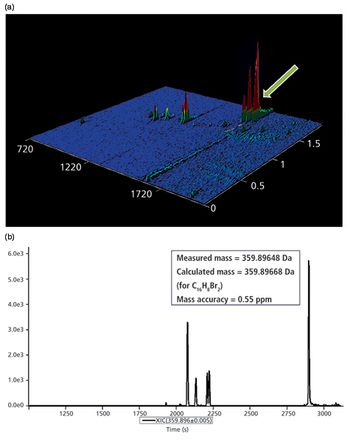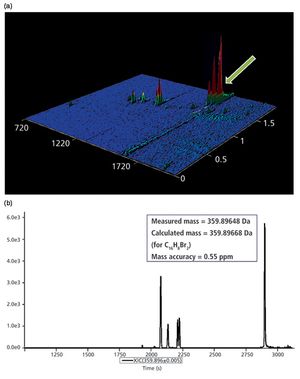
A snapshot of key trends and developments in the GC/GC–MS sector according to selected panelists from companies exhibiting at Analytica 2018.

A snapshot of key trends and developments in the GC/GC–MS sector according to selected panelists from companies exhibiting at Analytica 2018.

Terpenes contribute heavily to the senses of smell and taste and thus are integral to industries like herb and spice producers, essential oil manufacturers, cannabis growers and distributors, breweries, and distilleries, among countless others. Current terpene analysis is performed using gas chromatography–flame ionization detection (GC–FID) and GC–mass spectrometry (MS); however, baseline separation is needed for quantification because many terpenes of interest are isomers, which can lead to relatively long run times. Vacuum ultraviolet (VUV) spectroscopy can spectrally distinguish isomers and quantitatively deconvolve coeluting peaks, allowing for significant reduction in GC run time. This article outlines a method for the analysis of 21 terpenes in a variety of samples with a sub 9-min elution time.

While systems for growing, production and sale of cannabis and cannabis related products are well established, regulation and enforcement of quality and safety testing have lagged behind. However, state governments and private labs are focusing on product safety testing with special emphasis on pesticide analysis. This is partially the result of various product recalls, media attention and concern from patient advocacy groups. We evaluated a modified QuEChERS LC-MS/MS method for analysis of multiresidue pesticides. The AOAC QuEChERS method was used for a reduced 1.5 g amount of plant material and processed with a universal dSPE formulation. LC-MS/MS analysis used constant polarity switching ESI and monitored at least two transitions per analyte. Matrix-matched calibration was used for quantitation and both method and instrument internal standards were used. Analyte recovery validation was performed according to FDA guidelines by testing three matrices at three fortification levels in triplicate for over 200 pesticides. For the large majority of pesticides, in all three matrices and at all three fortification levels, recovery was between 70-120%.

“Practical GC” provides readers with practical advice and new experimental evidence for how to get the best results from their gas chromatography (GC) systems. The next instalment looks at the potential for reducing inlet adsorption of active compounds through the use of split injection GC.

Analyzing a broad range of semivolatile environmental pollutants at low levels requires a sensitive detector as well as an inert sample pathway. While semivolatiles analysis by methods such as EPA 8270 and EPA 625 typically does not require reporting sub nanogram-on-column concentrations, the latest generation of sensitive mass spectrometers and inert GC columns and inlet liners allow analysts to take advantage of the benefits of split injection while maintaining standard method reporting limits.

Jack Cochran’s new column “Practical GC” provides readers with practical advice and new experimental evidence for how to get the best results from their gas chromatography (GC) systems. This instalment looks at understanding and using split ratio for “shoot and dilute” GC.

Jack Cochran’s new column “Practical GC” provides readers with practical advice and new experimental evidence for how to get the best results from their gas chromatography (GC) systems. The next instalment looks at GC inlet liner choice for “shoot and dilute” GC.

Jack Cochran’s new column “Practical GC” aims to provide readers with practical advice and new experimental evidence for how to get the best results from their gas chromatography (GC) systems. The first article in a series on split injection GC focuses on the advantages of using “shoot-and-dilute” GC.

Wouldn’t it be nice if we could make nitrogen work for applications where helium is not an option?

This article compares results from samples prepared and analyzed according to EPA Method 1613B on a sector instrument with those from a high-resolution, accurate mass TOF mass spectrometer and a low-resolution TOF mass spectrometer interfaced to a comprehensive two-dimensional gas chromatography (GC) system (GC?C–TOF-MS).

Concurrent solvent recondensation–large volume splitless injection (CSR-LVSI), an alternative to programmed temperature vaporization (PTV), typically requires a special GC inlet. The technique described here uses an unmodified split/splitless inlet with CSR-LVSI to lower detection limits for the analysis of 1,4-dioxane in drinking water.

The authors evaluate a method for detecting pesticide residues in dandelion root powder.

The recent establishment of a 1 μg/g safety threshold for melamine in infant foods has led to an immediate need for more sensitive methods. Here we established GC–MS conditions for highly reproducible analyses and evaluated the effectiveness of both solvent-based and matrix-matched standards. Using this method, melamine and cyanuric acid were reliably detected at and below 1 μg/g in infant formula.

Published: July 1st 2013 | Updated:

Published: June 1st 2012 | Updated:

Published: November 1st 2010 | Updated:

Published: February 1st 2009 | Updated:

Published: October 26th 2015 | Updated:

Published: November 9th 2015 | Updated: